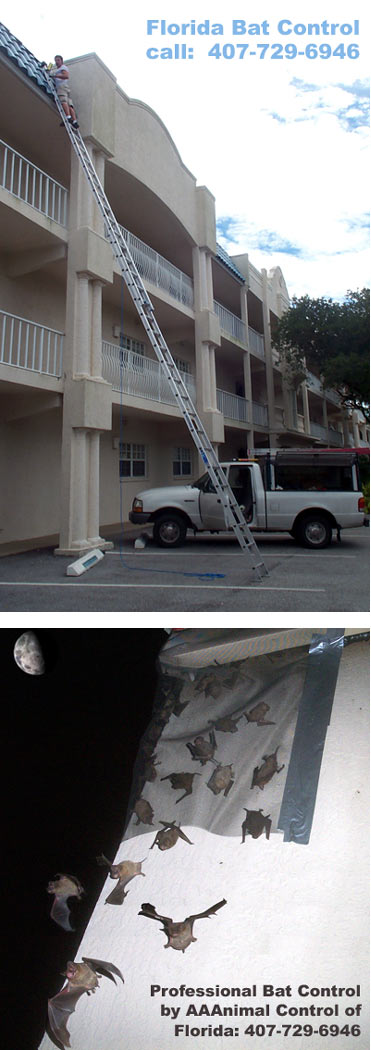-
info@aaanimalcontrol.com
Call us for help in your town
Humane Wildlife Education
Florida Commercial Bat Control & Removal Company
Need bat removal in your hometown? We service over 500 USA locations! Click here to hire us in your town and check prices - updated for year 2020.
AAAnimal Control is one of the leading bat control companies in the state of Florida. It is owned and operated by David Seerveld. AAAnimal Control has performed well over
100 bat exclusions throughout the state, with a 100% success rate.
I trained as a bat control apprentice for two years in the state of Pennsylvania, where I dealt primarily with colonizing Little Brown Bats (Myotis lucifugus). I moved to
Florida in 2002 to establish my own business. I studied the bats of Florida, and quickly found that in the vast majority of cases I was dealing with the Mexican Free-Tailed Bat
(Tadarida brasiliensis). The size and behavior of this bat, along with most colonizing bats in North America, is very similar to the Little Brown. The same professional exclusion
techniques that I learned in Pennsylvania applied to the bats in Florida.
Bats are often misunderstood creatures, surrounded by myth. For example, they are not blind. Their eyesight is normal, but they do rely upon sonar in order to find and catch
insects at night while on the wing. Bats are not aggressive, and have such good flight maneuverability that I?ve been in attics filled with hundreds of flying bats, and not one
been brushed by one. They will not fly into your hair. Bats are not the bloodsucking creatures of the night that folklore describes them as. They are an important part of our
ecosystem, and a gentle mammal. They are not related to rodents, but are in a branch of the animal kingdom more closely related to primates. They are valuable because they eat
millions of pest insects each night. It is true that bats, like all mammals, can carry rabies, and that bats are the #1 cause of rabies death in North America. However, it?s
important to note that incidence of rabies is not common in bats, and that disease transmission often occurs when a person handles a sick bat on the ground. A rabid bat will not
attack.
I find that the primary objection to bats is due to their odor, droppings, and general presence. Bats create about eight droppings per day. Multiply that by hundreds of bats
over the months or even years, and some buildings end up with severe contamination. If droppings continue to accumulate unabated for many years, they can harbor a fungus that
can cause a lung disease called Histoplasmosis. However, this disease is rarely fatal, and incidence of the fungus is not terribly common, except in cases of large and old guano
buildup. Most people do not like bats in their buildings because they leave these droppings everywhere, they swoop about at dusk and dawn, they can make a loud racket in numbers
with their vocal chirps, and they have a strong odor. I often exclude bats from commercial and apartment buildings in which the customers or tenants do not like the side effects
of these animals.
 |
 |
I am one of the few companies in the state of Florida that carries BCI certification for bat control. This is a special certification issued by Bat Conservation International that states that I meet the requirements for humane and professional bat control. Not many people understand how to do bat control correctly or legally. This is a highly specialized field, and few true experts exist. You can't hire your usual pest control company to do bat work. Amateurs usually make mistakes that kill bats, are illegal, and that ultimately don?t solve the problem permanently. I put a great deal of pride and dedication into my bat control work. It is my goal to humanely evict the entire colony without a single death, and to ensure that bats will never gain access to the building again. Thus far, I have met with my goal on every occasion.
AAAnimal Control wants to ensure that the job is done correctly from start to finish. If your building is contaminated with guano buildup, I strongly suggest guano removal and decontamination. AAAnimal Control safely removes all of the biohazard, and thoroughly decontaminates via biological enzyme-based agents via atomizer.
I look forward to solving your bat problem! -David Seerveld, AAAnimal Control
AAAnimal Control is a professional nuisance wildlife control company located in Orlando, FL. We offer solutions to wildlife problems throughout the Greater Orlando Florida area, and specialize in bat control. We offer professional bat control & removal for the entire state of Florida. For more info, go back to the bat removal page. Wildlife services include animal trapping, capture & removal, plus animal damage repairs and preventative measures. We also offer biological cleanup and many other services. Give us a call at 407-729-6946 any time to discuss your wildlife management issue and schedule an appointment. You can always browse this site for more details and info, and you can even check out prices ahead of time. If you live elsewhere in the US and have found this site and need a local trapper in your area, click here for a nationwide list of 100's of professional bat removal experts.


















